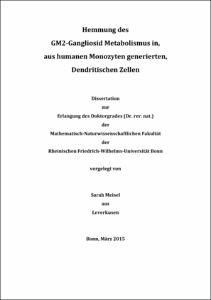Hemmung des GM2-Gangliosid Metabolismus in, aus humanen Monozyten generierten, Dendritischen Zellen

Hemmung des GM2-Gangliosid Metabolismus in, aus humanen Monozyten generierten, Dendritischen Zellen

| dc.contributor.advisor | Brossart, Peter | |
| dc.contributor.author | Meisel, Sarah | |
| dc.date.accessioned | 2020-04-21T07:01:23Z | |
| dc.date.available | 2020-04-21T07:01:23Z | |
| dc.date.issued | 06.07.2015 | |
| dc.identifier.uri | https://hdl.handle.net/20.500.11811/6489 | |
| dc.description.abstract | Seitdem man Ende der 80er Jahre mit der Verwendung von dendritischen Zellen in der immuntherapeutischen Behandlung von Krebs begann, wurden in klinischen Studien bereits einige Fortschritte, die zu einer verbesserten Prognose von Patienten beitrugen, erzielt. Jedoch sind DC-basierte Antitumorvakzinierungen bislang nur Chemotherapie-begleitend einsetzbar, da den induzierten Immunantworten eine ausreichende Aggressivität zur Auslöschung jeglicher Tumorzelle fehlt. Durch ihre Zelltyp-spezifische und Differenzierungsgrad-abhängige endogene Expression auf eukaryotischen Zellen und durch ihre extrinsische immunsupprimierende Wirkungsweise, wenn sie in charakteristischen Sekretionsprofilen von Tumorzellen abgegeben werden, wurde gezeigt, dass Ganglioside wichtige Modulatoren von Immunantworten sind. Durch die Beobachtung, dass eine GM2- bzw. GM2A-Expression in Monozyten fehlt, aber kontinuierlich während der Differenzierung zu unreifen MDCs steigt um dann in LPS-gereiften MDCs wieder verringert zu sein, lässt sich schlussfolgern, dass dieses Gangliosid eine essentielle Rolle hinsichtlich Überleben und Funktion in DCs haben könnte. In Anlehnung an die durch GM2-Akkumulation charakterisierten neurodegenerativen und letztendlich fatalen GM2-Gangliosidosen, Tay-Sachs (HexA), Sandhoff (HexA/HexB) und AB Variant (GM2A), wurden während dieser Arbeit beide am GM2-Metabolismus beteiligten Komponenten herunterreguliert; zum einen durch Anwendung von PUGNAc – ein chemischer Inhibitor der HexA – und zum anderen durch Elektrotransfektion mit einer GM2A-spezifischen siRNA. Während sich für die Hemmung des GM2-Aktivatorproteins keine phänotypischen und funktionellen Veränderungen nachweisen ließen – was wahrscheinlich auf einer verbliebenen Restaktivität durch eine nicht vollständige Hemmung des GM2A basiert – , konnten für die PUGNAc-bedingte Hemmung der HexA sowohl morphologische als auch funktionelle Beeinträchtigungen, deren Vehemenz in Korrelation zur angewandten Inhibitorkonzentration stand, nachgewiesen werden. Je höher die angewandte Inhibitorkonzentration war, desto drastischer war das Ausmaß der Beeinträchtigungen. Es konnte ein PUGNAc-bedingter Verlust der Phagozytoseaktivität unreifer MDCs, eine reduzierte Migrationsfähigkeit und allostimulatorische Kapazität in LPS-gereiften MDCs einhergehend mit einer Herunterregulierung der Expression bestimmter CD-Moleküle und einer stark verminderte Produktion proinflammatorischer Zytokine und Chemokine nachgewiesen werden. Aufgrund des funktionellen Einflusses und der deutlich gewordenen regulatorischen Importanz hinsichtlich der Immunogenität von MDCs stellt das GM2-Gangliosid und die, zu seinem Metabolismus unabdingbaren Komponenten, potente Faktoren zur Modifikation und Optimierung der DC-Immunogenität zu Zwecken der Tumorvakzinierung dar. | en |
| dc.description.abstract | Inhibition of the GM2 ganglioside metabolism in human monocyte derived dendritic cells Since the late 80’s when usage of dendritic cells in immunotherapeutic treatment of cancer began, some progress within clinical trials could be achieved, contributing to improved prognosis of patients. However, DC-based anti-tumor vaccinations are so far only chemotherapy concomitantly used, since the induced immune responses lack sufficient aggressiveness to remove all tumor cells. By their cell type-specific and differentiation-dependent endogenous expression on eukaryotic cells and their extrinsic immunosuppressive action, when submitted in characteristic secretion-profiles by tumor cells it could be shown that gangliosides are important modulators of immune responses. By the observation that the expression of GM2 (and GM2A resp.) is lacking in monocytes, but increases continuously during differentiation to MDCs to then again decrease in LPS-matured MDCs, the conclusion that there might be an essential role of this ganglioside towards DC-survival and function could be assumed. Relating to by GM2-accumulation characterized neurodegenerative and ultimately fatal GM2-gangliosidosis, Tay-Sachs (HexA), Sandhoff (HexA / HexB) and AB Variant (GM2a), both components involved in the GM2-metabolism were down-regulated during this work; on the one hand by the application of PUGNAc - a chemical inhibitor of HexA - and on the other hand by electrotransfection with a GM2A-specific siRNA. While no phenotypic and functional changes could be detected for the inhibition of the GM2-activator protein - which is probably based on a residual activity due to an incomplete inhibition of GM2A - for the PUGNAc-induced inhibition of HexA both morphological and functional impairments, with a vehemence correlating to the applied inhibitor concentrations, could be demonstrated. The higher the inhibitor concentration applied, the more drastic was the extent of deterioration. A PUGNAc-induced loss of phagocytic activity of immature MDCs, a reduced migratory ability and allostimulatory capacity in LPS-matured MDCs, accompanied by a down-regulated expression of certain CD-molecules and a greatly reduced production of proinflammatory cytokines and chemokines, was demonstrated. Due to the functional influence and the regulatory importancy regarding the immunogenicity of MDCs the GM2 ganglioside and the indispensable components to its metabolism, are potent factors for the modification and optimization of DC immunogenicity for tumor vaccination purposes. | en |
| dc.language.iso | deu | |
| dc.rights | In Copyright | |
| dc.rights.uri | http://rightsstatements.org/vocab/InC/1.0/ | |
| dc.subject | dendritische Zelle | |
| dc.subject | Immuntherapie | |
| dc.subject | GM2-Gangliosid | |
| dc.subject | GM2A | |
| dc.subject | HexA | |
| dc.subject | dendritic cells | |
| dc.subject | immunotherapy | |
| dc.subject | GM2 ganglioside | |
| dc.subject.ddc | 570 Biowissenschaften, Biologie | |
| dc.title | Hemmung des GM2-Gangliosid Metabolismus in, aus humanen Monozyten generierten, Dendritischen Zellen | |
| dc.type | Dissertation oder Habilitation | |
| dc.publisher.name | Universitäts- und Landesbibliothek Bonn | |
| dc.publisher.location | Bonn | |
| dc.rights.accessRights | openAccess | |
| dc.identifier.urn | https://nbn-resolving.org/urn:nbn:de:hbz:5n-40445 | |
| ulbbn.pubtype | Erstveröffentlichung | |
| ulbbnediss.affiliation.name | Rheinische Friedrich-Wilhelms-Universität Bonn | |
| ulbbnediss.affiliation.location | Bonn | |
| ulbbnediss.thesis.level | Dissertation | |
| ulbbnediss.dissID | 4044 | |
| ulbbnediss.date.accepted | 22.06.2015 | |
| ulbbnediss.institute | Mathematisch-Naturwissenschaftliche Fakultät : Fachgruppe Molekulare Biomedizin / Life & Medical Sciences-Institut (LIMES) | |
| ulbbnediss.fakultaet | Mathematisch-Naturwissenschaftliche Fakultät | |
| dc.contributor.coReferee | Burgdorf, Sven |
Dateien zu dieser Ressource
Das Dokument erscheint in:
-
E-Dissertationen (4434)




